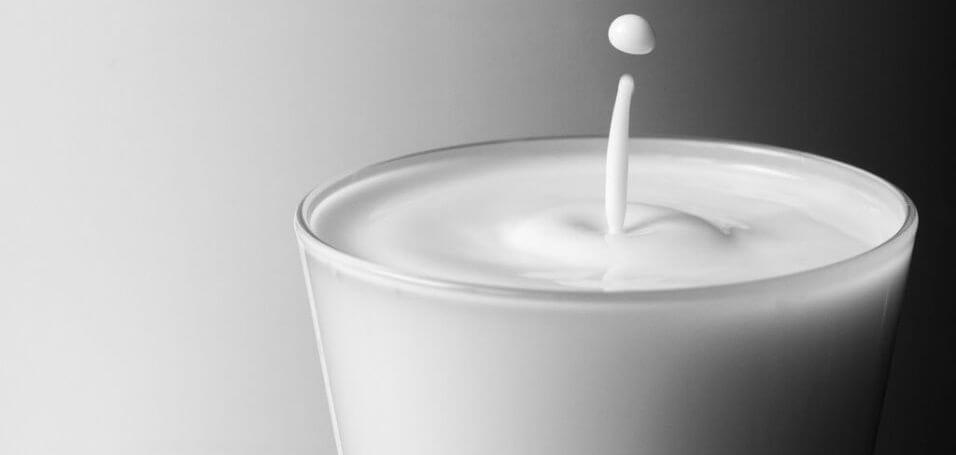- Babies grow a lot.
- Babies drink a lot of milk.
- Milk is good for getting bigger.
- You should drink a lot of milk if you want to grow bigger.
I’m pretty sure that’s how the “Gallon of Milk a Day,” or GOMAD Diet was conceived.
It’s equally simple to follow because the name alone tells you everything you need to know:
You drink an entire gallon of milk every day.
(You eat other food too, of course, but you’re not following the diet unless you’re getting down that gallon.)
Most people would say that’s silly, but when you’re struggling to gain weight and have tried just about everything but steroids, well, why not?
I mean, there are plenty of jacked dudes on the Internet that swear by GOMAD for gaining muscle fast and hitting PRs, so who knows…maybe there’s really something to it?
Unfortunately, it’s not that black and white.
Yes, GOMAD can help you gain weight faster…but a lot of it isn’t going to be the type of weight that you want to gain (fat).
You see, putting down a couple thousand calories of milk per day will certainly move the needle to the right, but it isn’t going to do much good for your body composition.
It’s not going to do your gut any favors, either.
That’s why there are much better ways to go about gaining weight, and in this article, I’m going to break it all down for you.
By the end, you’re going to know why people turn to GOMAD, what’s wrong with it, and how to go about gaining weight the right way.
Let’s get started.
- Why Do People Bother With GOMAD?
- The 4 Biggest Myths About the GOMAD Diet
- The Major Problem with the GOMAD Diet
- Want to Gain Muscle Faster? Forget GOMAD and Do This Instead
- The Bottom Line on the GOMAD Diet
Table of Contents
+Want to listen to more stuff like this? Check out my podcast!
Why Do People Bother With GOMAD?

GOMAD is most popular among people that consider themselves “hardgainers.”
Here’s how it usually goes:
Hardgainer is in gym doing biceps curls, complaining how hard it is to gain weight.
Gymbro overhears said complaint and says gaining weight is easy: add a gallon of milk per day to your diet.
Hardgainer is skeptical but desperate, and begins carrying milk with him everywhere he goes.
And he gains weight for the first time in a long time.
“Told ya,” gymbro says. “You gotta eat like a man and do what it takes!”
It would appear the GOMAD Diet worked. The fellow wanted to gain weight, and gain weight he did.
This story has played out in gyms all over the world, and I’ve even heard people claiming that GOMAD is better than steroids for gaining muscle. (Yeah…no.)
The reality is this:
If all you want to do is gain weight in any which way, then GOMAD “works.”
It’ll force you to eat a lot of calories and a lot of protein, and that plus some halfway sensible weightlifting is all it takes to gain weight.
If, however, you want to gain as much muscle and as little fat as possible, and do it without having explosive diarrhea every day, then GOMAD probably isn’t for you. You’re going to want to “lean bulk,” instead.
Before we talk about that, though, let’s pack off a few common misconceptions about GOMAD…
The 4 Biggest Myths About the GOMAD Diet
You already know where I stand on the GOMAD Diet–I think it’s dumb and unnecessary–but I’ll give it this:
It has its heart in the right place.
You see, you do need to eat quite a bit of food to gain muscle effectively, and this is easier said than done for many people.
They just don’t have the natural appetite for it and struggle to eat enough calories every day. They also often eat too little protein, as it’s the most filling and least tasty macronutrient.
Enter milk.
A gallon contains 128 grams of protein and just over 2,300 calories (at about 1/11th of the cost of most “meal replacement” or “mass gainer” supplements, I might add), making it perfect for increasing both caloric and protein intake.
It’s also rich in various micronutrients, making it a healthier choice than “dirty bulking” staples like pop tarts, ice cream and Oreos, and it’s about 87% water, so it helps ensure you’re drinking enough water, too.
The bottom line is if you’re looking to gain weight and want to drink calories, milk is an all-around good choice.
Is drinking milk better for muscle gain than just eating more food, though?
Proponents of GOMAD say it is. Here are some of the arguments commonly made for milk’s superiority:
- “It has the ideal macronutrient profile for muscle building.”
- “It has the best types of protein for gaining muscle.”
- “It has saturated fat, which boosts testosterone levels.”
- “It spikes insulin levels, which accelerates muscle growth.”
Let’s take a look at each of these claims.
1. “Milk has the ideal macronutrient profile for muscle building.”

Milk’s macros are fairly balanced, but this statement misses the forest for the trees.
As far as gaining muscle goes, what matters most is how much you’ve eaten by the end of every day, not the individual foods that got you there.
So sure, drinking milk provides you with protein, carbs, and fat in relatively equal proportions, but so do many other foods.
2. “Milk has the best types of protein for gaining muscle.”
Milk protein is about 80% casein and 20% whey.
Make no mistake, these are fantastic sources of protein. Some of the best, actually, because they’re well absorbed and contain high amounts of essential amino acids, which are vital to muscle growth.
Casein and whey also digest at different rates–whey digests quickly and casein much slower–which means milk both spikes your plasma (blood) amino acid levels and keeps them elevated for extended periods of time.
This is why studies have shown that milk makes a good post-workout meal, and why it is a good “muscle building food.”
What you may not know, though, is you can get all of the same benefits from other types of proteins, too.
The animal proteins that most of us like to eat, like meat, eggs, and other dairy products, are also digested and absorbed well by the body, are rich in amino acids, and digest at different rates.
3. “Milk has saturated fat, which boosts testosterone levels.”
High-fat diets are popular these days, and especially among guys looking to increase their testosterone levels.
As milk contains about 130 grams of fat per gallon, GOMAD makes it easy to eat a lot of fat.
The problem here, though, is twofold:
- Research shows that a high-fat diet can indeed increase testosterone levels…but the effects are far too small to significantly impact muscle building.
- A gallon of milk contains about 77 grams of saturated fat, and eating that much every day may increase the risk of heart disease in some people.
The bottom line is this:
- A high-carb diet is much better for gaining muscle than a high-fat one.
- Nobody needs to eat 100+ grams of fat per day to maintain a healthy endocrine system.
- And nobody should be gorging on saturated fat until we better understand its relationship to heart disease.
4. “Milk spikes insulin levels, which accelerates muscle growth.”
Insulin is a hormone responsible for shuttling nutrients into cells.
It’s also often believed that it’s anabolic, like testosterone, which is why many people think that more insulin production equals more muscle growth.
This isn’t exactly true.
Insulin doesn’t directly induce protein synthesis, so it’s not going to help you gain muscle in the same way as testosterone or even amino acids do.
It does have anti-catabolic properties, though, which means it reduces muscle breakdown rates, and this creates a more anabolic environment in the body. In this way, insulin is conducive to muscle growth.
The thing is, though, that you don’t need very much insulin to achieve these effects–a small meal will deliver more or less all of the muscle-related benefits that insulin has to offer.
“Spiking” insulin levels further by eating (or drinking) more won’t amplify these benefits.
The Major Problem with the GOMAD Diet

Most of what’s wrong with the GOMAD Diet stems from the mistaken idea that if a little bit of something is good, then a lot must be better.
I mentioned earlier that you have to eat a lot of food to gain muscle effectively.
This is because eating slightly more calories than you burn (a caloric surplus), positively affects many aspects of muscle building, ranging from hormones to various physiological processes and adaptations to training capacity and more.
And by “slightly,” I mean just 10 to 15% above your total daily energy expenditure.
Unfortunately, increasing that surplus doesn’t increase the rate at which you gain muscle. All it does is increase the rate at which you gain fat.
That’s why drinking a couple thousand calories per day in addition to your regular meals isn’t a good muscle building strategy.
Unless you burn an extraordinary amount of energy every day, it’s going to place you in a much larger caloric surplus than 10 to 15%, which is just going to make you more fat than swole.
Many people who recommend GOMAD try to play this down. One website claims that it’ll “only” cause your body fat percentage to rise by 2 to 3% per month.
Well, that’s a lowball estimate for many people, and even if it were accurate, it’s still too much. When bulking, I like to see people’s body fat percentage rise by no more than 1% per month.
There are even claims out there that guys can gain 20 to 30 pounds in just a month of GOMAD.
Well, it’s basically impossible to gain more than a few pounds of muscle in a month, even when you’re new to weightlifting and doing everything right, so that tells you what most of that weight gain is going to be comprised of.
The bottom line is this:
No matter how you slice it, GOMAD is lazy, loutish way to bulk.
The job calls for a scalpel, and it’s more like a truckload of Juggalos with chainsaws.
Equally detrimental to the unnecessary fat gain is the fact that it’ll probably explode your stomach (150 to 200 grams of lactose per day will do that to ya), and it reinforces poor eating habits that set you up for failure down the road.
Instead of teaching people to properly plan and control food intake, it teaches them to eat with reckless abandon and worry about the consequences later.
Want to Gain Muscle Faster? Forget GOMAD and Do This Instead

It’s safe to assume that you’re here because you want to know how to gain muscle faster.
And if you’re still reading, I hope I’ve convinced you by now that GOMAD isn’t a good diet for this.
What is, though?
Well, it doesn’t have a cool name, but it’s pretty simple…
1. Maintain a slight calorie surplus of 10 to 15%.
This is the “sweet spot” for “gaining lean muscle,” as they like to say.
By eating 10 to 15% more calories than you burn every day, you’ll maximize muscle growth and minimize fat gain.
If you’re not sure how to figure out how many calories you should eat, check out this article.
2. Get your macros right.
You’ve probably heard that a “calorie isn’t a calorie,” and when we’re talking body composition, this is very true.
When you want to gain muscle and/or lose fat, how your calories break down into protein, carbs, and fats is very important.
Calorie counting alone won’t guarantee success. You have to watch your “macros,” too.
Now, as we’re here to talk about gaining muscle, you should know that a high-protein, high-carb, and moderate/low-fat diet works best, and I explain why here.
3. Don’t shoot yourself in the foot with massive cheat days.
One of the biggest mistakes I see people make while bulking is egregious overeating.
A couple binges per week while is enough to double or even triple the rate at which you gain fat, which can quickly spiral out of control.
Don’t do this. Learn how to “cheat” intelligently instead.
4. Have realistic expectations for muscle and fat gain.
If you’re a guy who’s new to lifting weights, the most muscle you can hope to gain in your first year is 20 to 25 pounds. If you’re a girl, you can gain about half that.
In year two, your goal is to gain about half as much as year one, you can cut that in half again for year three (5 to 6 pounds for guys), and can expect no more than 3 to 5 pounds of muscle gain per year from there on.
As you can see, building a great physique takes time. There’s just no way around it.
Those numbers assume everything goes your way, too–that your diet is on point, that you follow a well-designed workout program, and that you don’t run into any setbacks that keep you out of the gym for extended periods of time.
You can also expect to gain muscle and fat at about a 1:1 ratio while in a caloric surplus.
That is, for every pound of muscle you gain, you can expect to gain about a pound of fat.
Some people are genetically blessed and can gain slightly more muscle than fat and others are at a genetic disadvantage and tend to gain more fat than muscle, but most of us fall in the middle.
Thus, here’s what bulking should look like for most people:
- 0.5 to 1 pound of weight gain per week.
- No more than 1% increase in body fat percentage per month.
Keep all this in mind when evaluating the claims of various “gurus” hawking their diet and training programs and supplements. If they’re promising more, they’re either ignorant or lying.
The Bottom Line on the GOMAD Diet
If you’re desperate to gain weight, GOMAD can look like the perfect solution.
It’s an easy, cheap way to pack in calories and protein, and it will cause that number on the scale to rise.
The problem, though, is it’ll also cause your waist measurement to rise, and quickly, which you’ll have to deal with at some point (and the fatter you get, the harder it’s going to be to get back to a respectable body fat percentage).
It also promotes unhealthy eating habits that are harder and harder to break over time.
So, I recommend that you pass on GOMAD and stick with the fundamentals of “lean bulking” and proper meal planning, instead.
They require a bit more know-how and effort, but they deliver way better short- and long-term results.
What’s your take on the GOMAD Diet? Have anything else to share? Let me know in the comments below!
Scientific References +
- Phillips, S. M. (2008). Insulin and muscle protein turnover in humans: Stimulatory, permissive, inhibitory, or all of the above? In American Journal of Physiology - Endocrinology and Metabolism (Vol. 295, Issue 4). Am J Physiol Endocrinol Metab. https://doi.org/10.1152/ajpendo.90569.2008
- Gelfand, R. A., & Barrett, E. J. (1987). Effect of physiologic hyperinsulinemia on skeletal muscle protein synthesis and breakdown in man. Journal of Clinical Investigation, 80(1), 1–6. https://doi.org/10.1172/JCI113033
- Fryburg, D. A., Jahn, L. A., Hill, S. A., Oliveras, D. M., & Barrett, E. J. (1995). Insulin and insulin-like growth factor-I enhance human skeletal muscle protein anabolism during hyperaminoacidemia by different mechanisms. Journal of Clinical Investigation, 96(4), 1722–1729. https://doi.org/10.1172/JCI118217
- Dorgan, J. F., Judd, J. T., Longcope, C., Brown, C., Schatzkin, A., Clevidence, B. A., Campbell, W. S., Nair, P. P., Franz, C., Kahle, L., & Taylor, P. R. (1996). Effects of dietary fat and fiber on plasma and urine androgens and estrogens in men: A controlled feeding study. American Journal of Clinical Nutrition, 64(6), 850–855. https://doi.org/10.1093/ajcn/64.6.850
- Wilkinson, S. B., Tarnopolsky, M. A., MacDonald, M. J., MacDonald, J. R., Armstrong, D., & Phillips, S. M. (2007). Consumption of fluid skim milk promotes greater muscle protein accretion after resistance exercise than does consumption of an isonitrogenous and isoenergetic soy-protein beverage. American Journal of Clinical Nutrition, 85(4), 1031–1040. https://doi.org/10.1093/ajcn/85.4.1031
- Hartman, J. W., Tang, J. E., Wilkinson, S. B., Tarnopolsky, M. A., Lawrence, R. L., Fullerton, A. V., & Phillips, S. M. (2007). Consumption of fat-free fluid milk after resistance exercise promotes greater lean mass accretion than does consumption of soy or carbohydrate in young, novice, male weightlifters. American Journal of Clinical Nutrition, 86(2), 373–381. https://doi.org/10.1093/ajcn/86.2.373
- Stark, M., Lukaszuk, J., Prawitz, A., & Salacinski, A. (2012). Protein timing and its effects on muscular hypertrophy and strength in individuals engaged in weight-training. In Journal of the International Society of Sports Nutrition (Vol. 9, p. 54). BioMed Central. https://doi.org/10.1186/1550-2783-9-54










